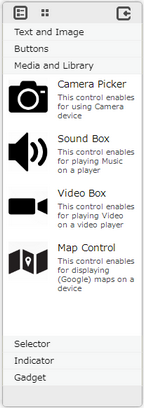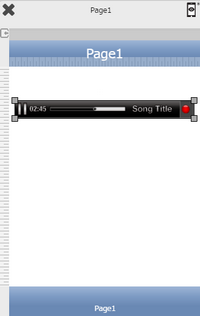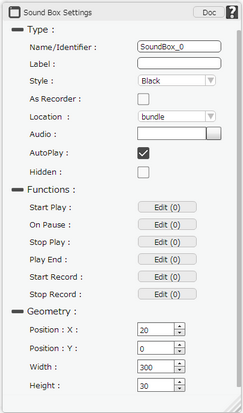Sound Box object, also called an audio player, provides playback of audio data from a file or memory. The Sound Player object lets user to play sound in any audio format available in smart phones.
Using a sound player user can:
1.Play sounds of any duration.
2.Play sounds from files or memory buffers.
3.Loop sounds.
4.Play multiple sounds simultaneously, one sound per audio player, with precise synchronization.
Note: User can place only one Sound Box on a particular page.
Step 1: To add a Sound Box click on the Media and Library tab in the UI toolbox.

Step 2: Drag and drop the Sound Box on the page.

Step 3: When the user drags and drops a Sound Box on the page, its properties appear automatically on the "Properties Palette window" on the right hand side. User can view the UI part properties by clicking on it's object figure whenever required. User can also edit each property to change the UI part object's figure as shown below.

List of Properties:-
Property |
Description |
Type |
|
Name/Identifier |
This must be a unique name that will identify the Sound Box, user may use this name to call the sound box or save information. |
Label |
Text entered in Label will be visible on the Sound Box. |
Style |
Style is the style of the sound UI on runtimes. It can be Black or Silver. |
As recorder |
As recorder option if selected the sound UI acts as a recorder. Note: Location option disappears when "As recorder" is selected. Recording ID , TimeOut(sec) appears. |
Recording ID
|
User can provide Recording ID for each recording done. This recording ID can be used for reference later. |
TimeOut
|
TimeOut property is the time in seconds.The recording will stop on completion of the Time mentioned in the TimeOut property. |
Location |
User can select Location of the SoundBox i.e URL or Local. Local- User can run a file which exists locally in the App. Bundle- The required file should be uploaded in Resource Manager. URL- User can run a file which is uploaded on any URL. |
Audio |
User need to upload the audio file here. This option is visible when Location is "Bundle". |
Local ID |
User need to provide the ID of the Audio file which is stored in the Application. This option is visible when Location is "Local". Note: User can use this Id for searching the file using "Set The Main Value" Action. |
Audio URL |
User need to provide Audio URL here whose Audio need to be played. This option is visible when Location is "URL". |
Autoplay |
If it is On, then sound plays automatically, otherwise it is off. |
Hidden |
This will hide the sound UI on different runtimes or platforms. |
Tab Order |
Tab order is a sequence number specified to the UI part. This allows user to select or transfer the control to the UI part as per the sequence number specified by pressing Tab Button on the keyboard. This functionality is available for Mobile web only. |
Functions
Functions act as trigger to launch the actions when a particular task is performed. To know more about Functions click here. |
|
Play End |
Event will occur when the play ends. |
Play Starts |
Event will occur when the play starts. |
On Pause |
Event will occur when the track is paused. |
Stop Play |
Event will occur when the user stops playing. |
Start Record |
Event will occur when recording starts. |
Stop Record |
Event will occur when recording stops. |
Geometry
|
|
Position : X |
Sets the position of Sound Box on the page horizontally. |
Position : Y |
Sets the position of Sound Box on the page vertically. |
Width |
Sets the width of Sound Box on the page. |
Height |
Sets the height of Sound Box on the page. |